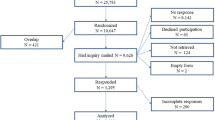Abstract
Financial relationships in academic research can create institutional conflicts of interest (COIs) because the financial interests of the institution or institutional officials may inappropriately influence decision-making. Strategies for dealing with institutional COIs include establishing institutional COI committees that involve the board of trustees in conflict review and management, developing policies that shield institutional decisions from inappropriate influences, and establishing private foundations that are independent of the institution to own stock and intellectual property and to provide capital to start-up companies.
Similar content being viewed by others
References
Association of American Medical Colleges. (2002). Protecting subjects, preserving trust, promoting progress II: Principles and recommendations for oversight of an institution’s financial interests in human subjects research. Washington, DC: Association of American Medical Colleges.
Association of American Medical Colleges, Association of American Universities. (2008). Protecting patients, preserving integrity, advancing health: Accelerating the implementation of COI policies in human subjects research. Washington, DC: Association of American Medical Colleges.
Association of Governing Boards of Colleges and Universities. (2009). AGB Board of Directors’ statement on conflict of interest. http://agb.org/news/2009-12/agb-board-directors-statement-conflict-interest. Accessed 7 Aug 2015.
Cooper, R. J., Gupta, M., Wilkes, M. S., & Hoffman, J. R. (2006). Conflict of interest disclosure policies and practices in peer-reviewed biomedical journals. Journal of General Internal Medicine, 21(12), 1248–1252.
Duke University. (2009). Institutional conflict of interest policy. http://duke.edu/services/ethicscompliance/coi/icoi_policy.php. Accessed 7 Aug 2015.
Fain, P., Bartlett, T., & Beja, M. (2010). Divided loyalties. The chronicleof higher education, March 4, 2010. http://chronicle.com/article/Divided-Loyalties-Conflicts/64629. Accessed 7 Aug 2015.
Friedberg, M., Saffran, B., Stinson, T., Nelson, W., & Bennett, C. (1999). Evaluation of conflict of interest in new drugs use in oncology. Journal of the American Medical Association, 282(15), 1453–1457.
Institute of Medicine. (2009). Committee on conflict of interest in medical research, education, and practice. In B. Lo & M. J. Field (Eds.), Conflict of interest in medical research, education, and practice. Washington, DC: National Academies Press.
Krimsky, S. (2003). Science in the private interest. Lanham, MD: Rowman and Littlefield.
Krimsky, S. (2007). When conflict-of-interest is a factor in scientific misconduct. Medical Law, 26, 447–463.
Lexchin, J. (2012). Those who have the gold make the evidence: How the pharmaceutical industry biases the outcomes of clinical trials of medications. Science and Engineering Ethics, 18(2), 247–261.
Lexchin, J., Bero, L. A., Djulbegovic, B., & Clark, O. (2003). Pharmaceutical industry sponsorship and research outcome and quality: Systematic review. British Medical Journal, 326(7400), 1167–1170.
Michaels, D. (2008). Doubt is their product. New York: Oxford University Press.
Moses, H., & Martin, B. (2001). Academic relationships with industry: A new model for biomedical research. Journal of the American Medical Association, 285(7), 933–935.
National Institutes of Health. (2013). Financial conflict of interest. http://grants.nih.gov/grants/policy/coi/. Accessed 7 Aug 2015.
National Science Foundation. (2005). Conflict of interest policies. http://www.nsf.gov/pubs/policydocs/pappguide/nsf08_1/aag_4.jsp. Accessed 7 Aug 2015.
Public Health Service. (2011). Objectivity in research. 42 Code of Federal Regulations 50.601.
Resnik, D. B. (2007). The price of truth: How money affects the norms of science. New York: Oxford University Press.
Resnik, D. B. (2008). COI issues in research misconduct investigations and inquiries. ORI Newsletter, 16(4), 1–4.
Resnik, D. B. (2011). Scientific research and the public trust. Science and Engineering Ethics, 17(3), 399–409.
Resnik, D. B., Ariansen J. L., Jamal, J., & Kissling, G. E. (2015). Institutional conflict of interest policies of U.S. academic institutions. Academic Medicine (in press).
Resnik, D. B., & Shamoo, A. S. (2002). Conflicts of interest and the university. Accountability in Research, 9(1), 45–64.
Ridker, P. M., & Torres, J. (2006). Reported outcomes in major cardiovascular clinical trials funded by for-profit and not-for-profit organizations: 2000–2005. Journal of the American Medical Association, 295(19), 2270–2274.
Rivlin, S. (2004). Scientific misconduct and its cover-up: Diary of a whistleblower. Boca Raton, FL: Brown Walker Press.
Shamoo, A. S., & Resnik, D. B. (2015). Responsible conduct of research (3rd ed.). New York: Oxford University Press.
Sismondo, S. (2008). Pharmaceutical company funding and its consequences: A qualitative systematic review. Contemporary Clinical Trials, 29(2), 109–113.
Smith, R. (2006). Research misconduct: Poisoning the well. Journal of the Royal Society of Medicine, 99(5), 232–237.
Stelfox, H., Chua, G., O’Rourke, K., & Detsky, A. (1998). Conflict of interest in the debate over calcium channel antagonists. New England Journal of Medicine, 338(2), 101–106.
University of North Carolina at Chapel Hill. (2009). The University of North Carolina at Chapel Hill Policy on institutional conflict of interest. http://www.unc.edu/campus/policies/institutional_policy.pdf. Accessed 17 Apr 2013.
Wadman, M. (2011). Report prods NIH to address institutional conflicts of interest. Nature News Blog, January 12, 2011. http://blogs.nature.com/news/2011/01/report_prods_nih_to_address_in.html. Accessed 15 Apr 2013.
Washington University. (2009). Washington University Policy on institutional conflict of interest. http://universitycompliance.wustl.edu/conflictofinterest/Documents/ICOI%20Policy.pdf. Accessed 7 Aug 2015.
Wolverton, B. (2012). Penn State’s culture of reverence led to ‘total disregard’ for children’s safety. The Chronicle of Higher Education, July 12, 2012. http://chronicle.com/article/Penn-States-Culture-of/132853/. Accessed 7 Aug 2015.
Acknowledgments
This article is the work product of an employee or group of employees of the National Institute of Environmental Health Sciences (NIEHS), National Institutes of Health (NIH). However, the statements, opinions or conclusions contained therein do not necessarily represent the statements, opinions or conclusions of the NIEHS, NIH, or the United States government.
Author information
Authors and Affiliations
Corresponding author
Rights and permissions
About this article
Cite this article
Resnik, D.B. Institutional Conflicts of Interest in Academic Research. Sci Eng Ethics 25, 1661–1669 (2019). https://doi.org/10.1007/s11948-015-9702-9
Received:
Accepted:
Published:
Issue Date:
DOI: https://doi.org/10.1007/s11948-015-9702-9




